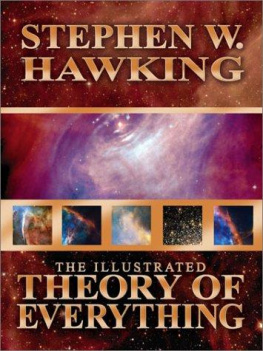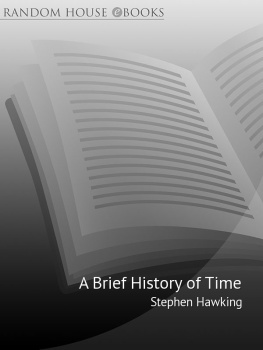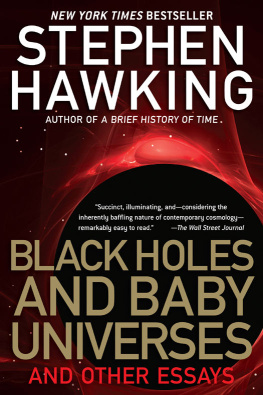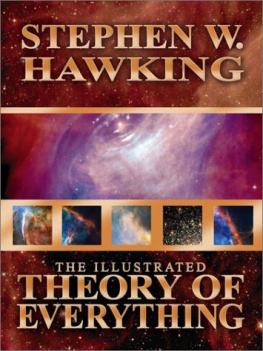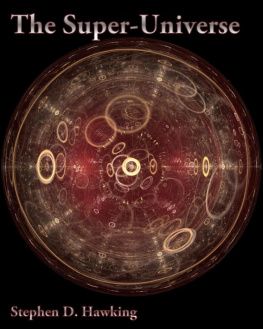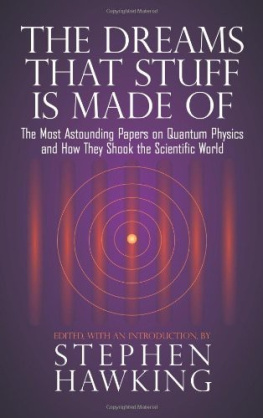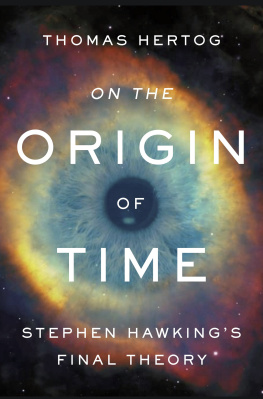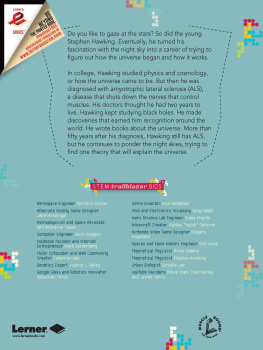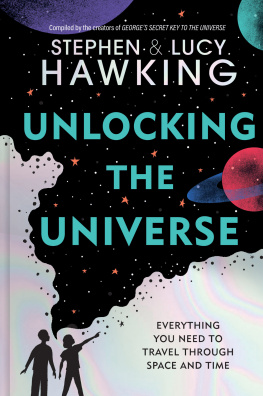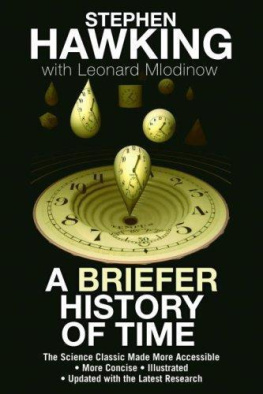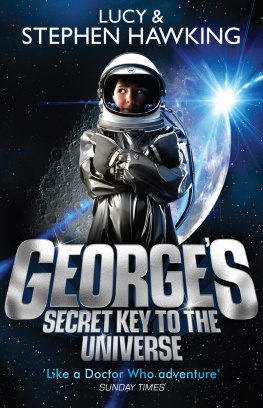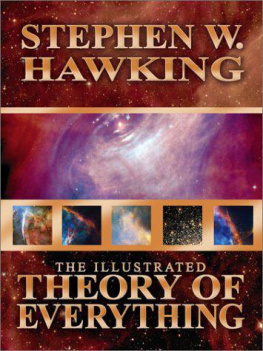Hawking - The Theory of Everything: The Origin and Fate of the Universe
Here you can read online Hawking - The Theory of Everything: The Origin and Fate of the Universe full text of the book (entire story) in english for free. Download pdf and epub, get meaning, cover and reviews about this ebook. year: 2010, genre: Science. Description of the work, (preface) as well as reviews are available. Best literature library LitArk.com created for fans of good reading and offers a wide selection of genres:
Romance novel
Science fiction
Adventure
Detective
Science
History
Home and family
Prose
Art
Politics
Computer
Non-fiction
Religion
Business
Children
Humor
Choose a favorite category and find really read worthwhile books. Enjoy immersion in the world of imagination, feel the emotions of the characters or learn something new for yourself, make an fascinating discovery.
The Theory of Everything: The Origin and Fate of the Universe: summary, description and annotation
We offer to read an annotation, description, summary or preface (depends on what the author of the book "The Theory of Everything: The Origin and Fate of the Universe" wrote himself). If you haven't found the necessary information about the book — write in the comments, we will try to find it.
Hawking: author's other books
Who wrote The Theory of Everything: The Origin and Fate of the Universe? Find out the surname, the name of the author of the book and a list of all author's works by series.
The Theory of Everything: The Origin and Fate of the Universe — read online for free the complete book (whole text) full work
Below is the text of the book, divided by pages. System saving the place of the last page read, allows you to conveniently read the book "The Theory of Everything: The Origin and Fate of the Universe" online for free, without having to search again every time where you left off. Put a bookmark, and you can go to the page where you finished reading at any time.
Font size:
Interval:
Bookmark:
The Theory of Everything: The Origin and Fate of the Universe
By Hawking, Stephen
INTRODUCTION
In this series of lectures I shall try to give an outline of what we think is thehistory of the universe from the big bang to black holes. In the first lectureI shall briefly review past ideas about the universe and how we got to ourpresent picture. One might call this the history of the history of the universe.
In the second lecture I shall describe how both Newtons and Einsteins the-ories of gravity led to the conclusion that the universe could not be static; ithad to be either expanding or contracting. This, in turn, implied that theremust have been a time between ten and twenty billion years ago when thedensity of the universe was infinite. This is called the big bang. It would havebeen the beginning of the universe.
In the third lecture I shall talk about black holes. These are formed when amassive star or an even larger body collapses in on itself under its owngravitational pull. According to Einsteins general theory of relativity, anyonefoolish enough to fall into a black hole will be lost forever. They will not beable to come out of the black hole again. Instead, history, as far as they areconcerned, will come to a sticky end at a singularity. However, generalrelativity is a classical theory-that is, it doesnt take into account theuncertainty principle of quantum mechanics.
In the fourth lecture I shall describe how quantum mechanics allows energy toleak out of black holes. Black holes arent as black as they are painted.In the fifth lecture I shall apply quantum mechanical ideas to the big bang andthe origin of the universe. This leads to the idea that space-time may be finitein extent but without boundary or edge. It would be like the surface of theEarth but with two more dimensions.In the sixth lecture I shall show how this new boundary proposal could explainwhy the past is so different from the future, even though the laws of physics aretime symmetric.
Finally, in the seventh lecture I shall describe how we are trying to find aunified theory that will include quantum mechanics, gravity, and all the otherinteractions of physics. If we achieve this, we shall really understand theuniverse and our position in it.
As long ago as 340 B.C. Aristotle, in his book On the Heavens, was able toput forward two good arguments for believing that the Earth was a roundball rather than a flat plate. First, he realized that eclipses of the moon werecaused by the Earth coming between the sun and the moon. The Earths shad-ow on the moon was always round, which would be true only if the Earth wasspherical. If the Earth had been a flat disk, the shadow would have been elon-gated and elliptical, unless the eclipse always occurred at a time when the sunwas directly above the center of the disk.
Second, the Greeks knew from their travels that the Pole Star appeared lowerin the sky when viewed in the south than it did in more northerly regions.From the difference in the apparent position of the Pole Star in Egypt andGreece, Aristotle even quoted an estimate that the distance around the Earthwas four hundred thousand stadia. It is not known exactly what length a sta-dium was, but it may have been about two hundred yards. This would makeAristotles estimate about twice the currently accepted figure.The Greeks even had a third argument that the Earth must be round, for whyelse does one first see the sails of a ship coming over the horizon and only latersee the hull? Aristotle thought that the Earth was stationary and that the sun,the moon, the planets, and the stars moved in circular orbits about the Earth.He believed this because he felt, for mystical reasons, that the Earth was thecenter of the universe and that circular motion was the most perfect.
This idea was elaborated by Ptolemy in the first century A.D. into a completecosmological model. The Earth stood at the center, surrounded by eightspheres, which carried the moon, the sun, the stars, and the five planets knownat the time: Mercury, Venus, Mars, Jupiter, and Saturn. The planets themselvesmoved on smaller circles attached to their respective spheres in order toaccount for their rather complicated observed paths in the sky. The outermostsphere carried the so-called fixed stars, which always stay in the same positionsrelative to each other but which rotate together across the sky. What laybeyond the last sphere was never made very clear, but it certainly was not partof mankinds observable universe.
Ptolemys model provided a reasonably accurate system for predicting thepositions of heavenly bodies in the sky. But in order to predict these positionscorrectly, Ptolemy had to make an assumption that the moon followed a paththat sometimes brought it twice as close to the Earth as at other times. Andthat meant that the moon had sometimes to appear twice as big as it usuallydoes. Ptolemy was aware of this flaw but nevertheless his model was generally,although not universally, accepted. It was adopted by the Christian church asthe picture of the universe that was in accordance with Scripture. It had thegreat advantage that it left lots of room outside the sphere of fixed stars forheaven and hell.
A much simpler model, however, was proposed in 1514 by a Polish priest,Nicholas Copernicus. At first, for fear of being accused of heresy, Copernicuspublished his model anonymously. His idea was that the sun was stationary atthe center and that the Earth and the planets moved in circular orbits aroundthe sun. Sadly for Copernicus, nearly a century passed before this idea was tobe taken seriously. Then two astronomers-the German, Johannes Kepler, andthe Italian, Galileo Galilei-started publicly to support the Copernican theo-ry, despite the fact that the orbits it predicted did not quite match the onesobserved. The death of the Aristotelian-Ptolemaic theory came in 1609. Inthat year Galileo started observing the night sky with a telescope, which hadjust been invented.
When he looked at the planet Jupiter, Galileo found that it was accompa-nied by several small satellites, or moons, which orbited around it. Thisimplied that everything did not have to orbit directly around the Earth asAristotle and Ptolemy had thought. It was, of course, still possible to believethat the Earth was stationary at the center of the universe, but that themoons of Jupiter moved on extremely complicated paths around the Earth,giving the appearance that they orbited Jupiter. However, Copernicusstheory was much simpler.
At the same time, Kepler had modified Copernicuss theory, suggesting that theplanets moved not in circles, but in ellipses. The predictions now finallymatched the observations. As far as Kepler was concerned, elliptical orbits weremerely an ad hoc hypothesis-and a rather repugnant one at that becauseellipses were clearly less perfect than circles. Having discovered, almost by acci-dent, that elliptical orbits fitted the observations well, he could not reconcilewith his idea that the planets were made to orbit the sun by magnetic forces.An explanation was provided only much later, in 1687, when Newton pub-lished his Principia Mathematica Naturalis Causae. This was probably the mostimportant single work ever published in the physical sciences. In it, Newtonnot only put forward a theory of how bodies moved in space and time, but healso developed the mathematics needed to analyze those motions. In addition,Newton postulated a law of universal gravitation. This said that each body inthe universe was attracted toward every other body by a force which wasstronger the more massive the bodies and the closer they were to each other.It was the same force which caused objects to fall to the ground. The story thatNewton was hit on the head by an apple is almost certainly apocryphal. AllNewton himself ever said was that the idea of gravity came to him as he sat ina contemplative mood, and was occasioned by the fall of an apple.
Font size:
Interval:
Bookmark:
Similar books «The Theory of Everything: The Origin and Fate of the Universe»
Look at similar books to The Theory of Everything: The Origin and Fate of the Universe. We have selected literature similar in name and meaning in the hope of providing readers with more options to find new, interesting, not yet read works.
Discussion, reviews of the book The Theory of Everything: The Origin and Fate of the Universe and just readers' own opinions. Leave your comments, write what you think about the work, its meaning or the main characters. Specify what exactly you liked and what you didn't like, and why you think so.

